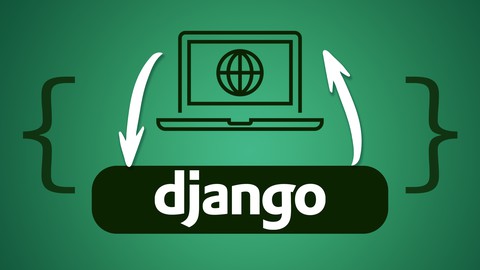
Python Django – The Practical Guide
Python Django – The Practical Guide, available at $109.99, has an average rating of 4.61, with 257 lectures, based on 7629 reviews, and has 46844 subscribers.
You will learn about Learn how to use Python for web development with Django Build real projects and apply what you learned in a full blog website created in the course Choose between the full course or the included course summary to get you started quickly This course is ideal for individuals who are Python developers who want to take the next step and dive into web development with Python or JavaScript developers who want to explore Python for web development or Everyone interested in learning how to build websites with Python It is particularly useful for Python developers who want to take the next step and dive into web development with Python or JavaScript developers who want to explore Python for web development or Everyone interested in learning how to build websites with Python.
Enroll now: Python Django – The Practical Guide
Summary
Title: Python Django – The Practical Guide
Price: $109.99
Average Rating: 4.61
Number of Lectures: 257
Number of Published Lectures: 257
Number of Curriculum Items: 257
Number of Published Curriculum Objects: 257
Original Price: $199.99
Quality Status: approved
Status: Live
What You Will Learn
- Learn how to use Python for web development with Django
- Build real projects and apply what you learned in a full blog website created in the course
- Choose between the full course or the included course summary to get you started quickly
Who Should Attend
- Python developers who want to take the next step and dive into web development with Python
- JavaScript developers who want to explore Python for web development
- Everyone interested in learning how to build websites with Python
Target Audiences
- Python developers who want to take the next step and dive into web development with Python
- JavaScript developers who want to explore Python for web development
- Everyone interested in learning how to build websites with Python
Python is the most popular programming language of the world – it is versatile, easy to learn and very powerful!
But one of the primary things you can build with Python is a website! You can use Python for web development.
And to make that easier, you would typically use a framework like Django – simply because that allows you to focus on your core business logic and you don’t need to re-invent the wheel and implement all the nitty-gritty technical details from scratch.
This course is about Django – the most popular Python web development framework out there!
Django covers all aspects of web development – from handling requests and responses, over rendering dynamic HTML pages with templates, all the way up to making database access and data management easy. It’s all baked in and it’s all covered in great detail in this course!
This course teaches Django from the ground up – you don’t need to know anything about it to get started. Basic Python and web development knowledge is all you need.
We’ll start at the absolute basics and understand how to create Django project, how to run them and how to add features – step by step.
In detail, this course covers:
-
Installing Django
-
Creating and understanding Django projects
-
Understanding URLs, views, requests and responses
-
Working with templates and static files like CSS and images
-
Working with data and models
-
Connecting data with relationships (one-to-many, one-to-one, many-to-many)
-
Querying data with Django’s powerful model solution
-
Adding administration panels to your projects
-
Handling user input with forms – manually and with Django’s built-in form support
-
Advanced features like class-based views (and when to use them)
-
Dealing with file uploads and how to serve uploaded files
-
Working with sessions
-
In-depth deployment instructions and examples
-
Different ways of deploying and serving static files and user uploads
-
And much more!
All those concepts are taught in great depth and backed up by a complete example course project where we build a “Blog website” from the ground up.
Therefore, you’ll learn all the important concepts and the theory and you’re also going to be able to see it applied to a real project.
Hence, once you completed the course, you’ll have a very solid understanding of Django and you’ll be able to dive into your own Django projects!
Course Curriculum
Chapter 1: Getting Started
Lecture 1: Introduction
Lecture 2: What is Django?
Lecture 3: The Course Prerequisites
Lecture 4: What's Inside the Course?
Lecture 5: Join Our Learning Community!
Lecture 6: Getting the Most out of the Course
Lecture 7: Choose Your Course Path!
Lecture 8: Course Setup
Chapter 2: Course Setup
Lecture 1: Module Introduction
Lecture 2: Installing Python & Django
Lecture 3: Creating a Django Project
Lecture 4: Installing an IDE
Lecture 5: Analyzing the Created Project
Lecture 6: Starting a Development Server
Lecture 7: Django Apps
Lecture 8: Analyzing the Created Project
Lecture 9: More Advanced Setup Steps
Lecture 10: Useful Resources & Links
Chapter 3: URLs & Views
Lecture 1: Module Introduction
Lecture 2: Creating a New Project
Lecture 3: What are URLs & Views?
Lecture 4: Creating a First View & URL
Lecture 5: Adding More Views & URLs
Lecture 6: Dynamic Path Segments & Captured Values
Lecture 7: Path Converters
Lecture 8: Adding More Dynamic View Logic
Lecture 9: Redirects
Lecture 10: The Reverse Function & Named URLs
Lecture 11: Returning HTML
Lecture 12: Practicing URLs, Views & Dynamic View Logic
Lecture 13: Summary
Lecture 14: Useful Resources & Links
Chapter 4: Templates & Static Files
Lecture 1: Module Introduction
Lecture 2: Adding & Registering Templates
Lecture 3: Rendering Templates
Lecture 4: Template Language & Variable Interpolation
Lecture 5: Exercise Solution
Lecture 6: Filters
Lecture 7: The Django Visual Studio Code Extension
Lecture 8: Tags & the "for" Tag
Lecture 9: The URL Tag for Dynamic URLs
Lecture 10: The "if" Tag for Conditional Content
Lecture 11: Template Inheritance
Lecture 12: Exercise Solution
Lecture 13: Including Partial Template Snippets
Lecture 14: More on the Django Template Language (DTL)
Lecture 15: 404 Templates
Lecture 16: Adding Static Files
Lecture 17: Adding Global Static Files
Lecture 18: Adding CSS Styling
Lecture 19: Building Static URLs Dynamically
Lecture 20: Summary
Lecture 21: Useful Resources & Links
Chapter 5: Course Project: Building a Blog – The Basics
Lecture 1: Module Introduction
Lecture 2: Setting Up the Starting Project
Lecture 3: Planning the Project
Lecture 4: Adding URLs & Views
Lecture 5: Adding First Templates
Lecture 6: Template Content & Static Files
Lecture 7: Adding Images as Static Files
Lecture 8: Adding the "All Posts" Page & Style
Lecture 9: Linking the Pages
Lecture 10: Adding the "Single Post" Page
Lecture 11: Adding Dummy Data to the "Views" File
Lecture 12: Special Template Features & Syntax
Lecture 13: Adding a Single Post Page
Lecture 14: Adding a 404 Page
Lecture 15: Useful Resources & Links
Chapter 6: Data & Models
Lecture 1: Module Introduction
Lecture 2: Different Kinds of Data
Lecture 3: Understanding Database Options
Lecture 4: Understanding SQL
Lecture 5: Django Models
Lecture 6: Creating a Django Model with Fields
Lecture 7: Migrations
Lecture 8: Inserting Data
Lecture 9: Getting all Entries
Lecture 10: Updating Models & Migrations
Lecture 11: Blank vs Null
Lecture 12: Updating Data
Lecture 13: Deleting Data
Lecture 14: Create Instead of Save
Lecture 15: Querying & Filtering Data
Lecture 16: "or" Conditions
Lecture 17: Query Performance
Lecture 18: Bulk Operations
Lecture 19: Preparing Templates
Lecture 20: Rendering Queried Data in the Template
Lecture 21: Rendering the Details Page
Lecture 22: Model URLs
Lecture 23: Adding a Slugfield & Overwriting Save
Lecture 24: Using the Slug & Updating Field Options
Lecture 25: Aggregation & Ordering
Lecture 26: Summary
Instructors
-
Academind by Maximilian Schwarzmüller
Online Education -
Maximilian Schwarzmüller
AWS certified, Professional Web Developer and Instructor
Rating Distribution
- 1 stars: 62 votes
- 2 stars: 75 votes
- 3 stars: 365 votes
- 4 stars: 2082 votes
- 5 stars: 5045 votes
Frequently Asked Questions
How long do I have access to the course materials?
You can view and review the lecture materials indefinitely, like an on-demand channel.
Can I take my courses with me wherever I go?
Definitely! If you have an internet connection, courses on Udemy are available on any device at any time. If you don’t have an internet connection, some instructors also let their students download course lectures. That’s up to the instructor though, so make sure you get on their good side!
You may also like
- Top 10 Financial Technology Courses to Learn in December 2024
- Top 10 Agile Methodologies Courses to Learn in December 2024
- Top 10 Project Management Courses to Learn in December 2024
- Top 10 Leadership Skills Courses to Learn in December 2024
- Top 10 Public Speaking Courses to Learn in December 2024
- Top 10 Affiliate Marketing Courses to Learn in December 2024
- Top 10 Email Marketing Courses to Learn in December 2024
- Top 10 Social Media Management Courses to Learn in December 2024
- Top 10 SEO Optimization Courses to Learn in December 2024
- Top 10 Content Creation Courses to Learn in December 2024
- Top 10 Game Development Courses to Learn in December 2024
- Top 10 Software Testing Courses to Learn in December 2024
- Top 10 Big Data Courses to Learn in December 2024
- Top 10 Internet Of Things Courses to Learn in December 2024
- Top 10 Quantum Computing Courses to Learn in December 2024
- Top 10 Cloud Computing Courses to Learn in December 2024
- Top 10 3d Modeling Courses to Learn in December 2024
- Top 10 Mobile App Development Courses to Learn in December 2024
- Top 10 Graphic Design Courses to Learn in December 2024
- Top 10 Videography Courses to Learn in December 2024























